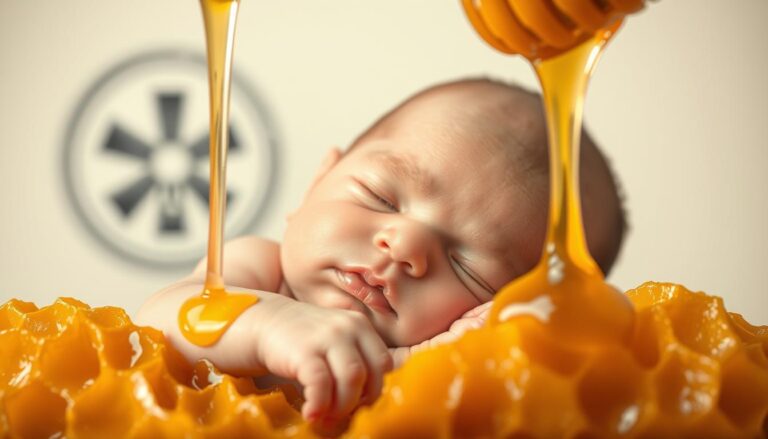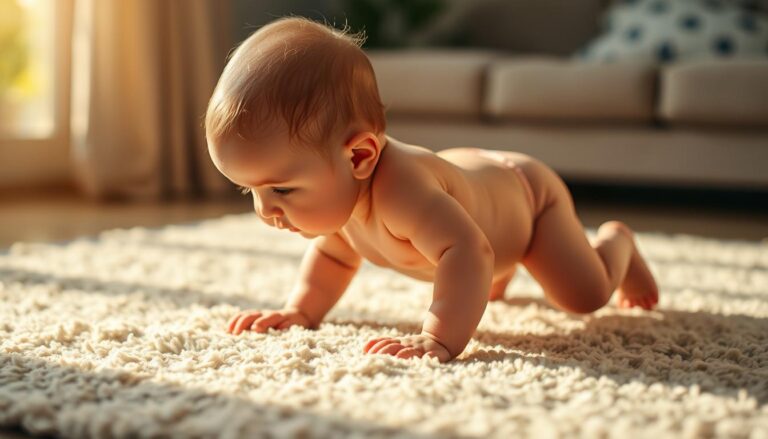Crawling is a significant milestone in a baby’s development, marking a crucial phase in their physical growth and mobility. It’s a period that parents eagerly anticipate, as it signifies their baby’s progress toward independence. Research indicates that baby crawling age typically falls between 7 and 10 months. During this time, babies begin to explore their surroundings in a new way, strengthening their muscles and improving their coordination. when do babies start crawling As babies begin to crawl, they’re not just moving from one place to another; they’re also developing crawling development skills that are foundational for future physical milestones, such as walking and running. Key Takeaways The Typical Age Range for Crawling The age at which babies start crawling can vary, but there is a general age range considered typical for this developmental milestone. Understanding this range and the factors that influence it can help parents better anticipate and support their baby’s development. Average Crawling Milestones by Month Most babies begin crawling between 7 and 10 months of age. By 6 months, some babies may start showing signs of crawling, such as rocking back and forth on their hands and knees. By 7 months, many babies have developed the strength and coordination needed to start crawling. By 9 months, most babies are crawling proficiently, and by 10 months, many are pulling themselves up to stand. It’s essential for parents to remember that these are just averages, and the actual age at which their baby starts crawling can be influenced by various factors, including genetics, environment, and overall health. Normal Variations in Crawling Timeline While the average range for crawling is between 7 and 10 months, normal variations exist. Some babies might start as early as 6 months or as late as 11 months. Factors such as premature birth, muscle tone, and opportunities for tummy time can influence when a baby starts crawling. Early vs. Late Crawlers: What Research Shows Research on early versus late crawlers suggests that both can be within the normal range. Studies have shown that factors such as genetics and environment play a significant role in determining when a baby starts crawling. While some research indicates that early crawlers might have an advantage in terms of motor skill development, others suggest that late crawlers can still develop normally. Ultimately, what’s most important is that the baby is making progress in their developmental milestones. Developmental Stages Leading to Crawling The journey to crawling involves several key developmental stages that lay the foundation for this important skill. These stages are crucial for building the strength, coordination, and confidence needed for crawling. Head Control and Neck Strength Gaining head control is one of the earliest signs of neurological development in infants. As babies strengthen their neck muscles, they are able to hold their heads up while on their stomachs, which is a fundamental precursor to crawling. Neck strength is essential for maintaining proper posture and facilitating movement. Rolling Over and Core Strength Rolling over is another significant milestone that indicates developing core strength. When babies learn to roll from their stomachs to their backs and vice versa, they are building the necessary muscles for more complex movements like crawling. This action helps in strengthening their core and improving overall physical coordination. Sitting Independently Sitting independently is a critical stage that precedes crawling. It requires balance, coordination, and sufficient back and neck strength. By sitting up, babies are able to explore their surroundings more effectively and prepare their bodies for further mobility. Pre-Crawling Movements to Watch For Before babies start crawling, they often exhibit pre-crawling movements such as rocking on hands and knees, pivoting, or making crawling motions with their legs while on their stomachs. These movements are indicative of their readiness to crawl and should be encouraged. Developmental Stage Age Range Key Milestones Head Control 1-4 months Holding head up while on stomach Rolling Over 2-6 months Rolling from stomach to back and vice versa Sitting Independently 4-7 months Sitting up without support Pre-Crawling Movements 6-10 months Rocking, pivoting, and crawling motions When Do Babies Start Crawling: Understanding the Process The development of crawling in babies is a multifaceted process that involves physical strength, genetics, and environmental factors. As babies progress from infancy to toddlerhood, crawling becomes a crucial milestone that signifies their growing mobility and independence. The Progression from Tummy Time to Mobility Tummy time is a critical component in the development of crawling. It helps strengthen the neck, back, and arm muscles, which are essential for crawling. During tummy time, babies learn to lift their heads, shoulders, and eventually their hips, laying the groundwork for more complex movements like crawling. As babies become more comfortable with tummy time, they begin to exhibit pre-crawling movements such as rocking back and forth, pushing up with their hands, and eventually moving their arms and legs in a crawling motion. Individual Factors Affecting Crawling Timeline The timeline for crawling can vary significantly among babies due to individual factors. Two significant influences are genetics and environmental factors. Genetics and Family Patterns Genetics play a role in determining when a baby will start crawling. If parents were early or late crawlers, their babies might follow a similar pattern. Research suggests that genetic predispositions can influence developmental milestones, including crawling. Environmental Influences Environmental influences, such as the amount of tummy time a baby gets and the space available for them to move, can also impact the crawling timeline. Babies who have more opportunities to practice tummy time and move around are likely to start crawling earlier. Factor…


